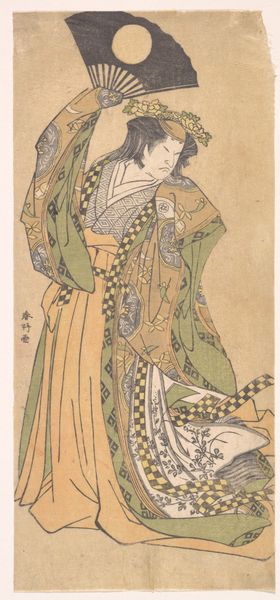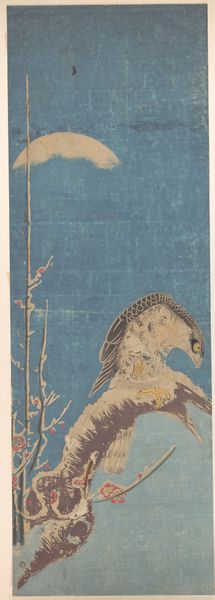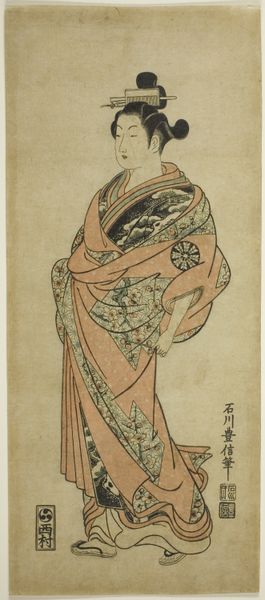
print, textile
#
portrait
# print
#
asian-art
#
textile
#
ukiyo-e
#
figuration
#
men
#
genre-painting
Dimensions: H. 26 5/16 in. (66.8 cm); W. 4 3/4 in. (12.1 cm)
Copyright: Public Domain
Curator: This beautiful, slender print is titled “The Love Letter,” and it’s attributed to Torii Kiyonaga, dating from around 1767 to 1799. We’re lucky enough to have it here at the Metropolitan Museum of Art. Editor: It's striking how the vertical format accentuates the elongated figures. And the subdued palette lends the whole scene a serene, almost melancholy, mood. I wonder about the physical process of making such a delicate thing. Curator: Kiyonaga was a master of Ukiyo-e prints. We should appreciate that this wasn’t some spontaneous creation—it would have involved a team of artisans, from the artist to the block carvers, to the printers themselves. Each colour would have been applied from a separate woodblock. Editor: That collaborative process is fascinating. The choice of textile patterns, too, seem very deliberate, perhaps indicating social status, marital eligibility. How was the use of specific textile designs policed or promoted during that period? Did guilds govern such things? Curator: It's more about symbolic communication, a sophisticated visual language for the viewers. Take the Kabuki theatre – popular entertainment influencing everything from hairstyles to fashion. Did you know Ukiyo-e prints were the mass media of their day? Editor: Like postcards! But elevated to art, because the materials mattered. How does this specific print fit within the Ukiyo-e tradition and broader societal norms? Are there other Ukiyo-e artworks focused on love letters from this period? And were these types of prints marketed at wealthy patrons? Curator: Well, you'd definitely find similar themes and figure types. What's so special about Kiyonaga is that he brings an understated sophistication. In some sense it’s genre painting that democratized imagery that was once reserved for the elites. And yes, many were marketed for a merchant clientele. Editor: Democratization through prints! Seeing those patterns, though, the wood grain—makes me wish I could analyze them in hand rather than from behind glass. Curator: I understand. Perhaps looking at the circumstances through which these works entered museum collections like ours would allow another fascinating angle of the materiality!
Comments
No comments
Be the first to comment and join the conversation on the ultimate creative platform.













